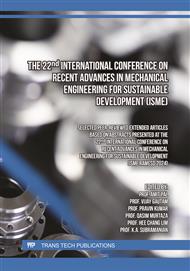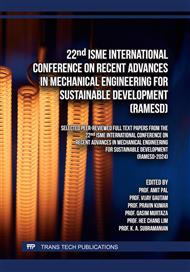[1]
Luxin Yu, Xianguang Gu, Lijun Qian, Ping Jiang, Wei Wang, Ming Yu, Application of tailor rolled blanks in optimum design of pure electric vehicle crashworthiness and lightweight, Thin-Walled Structures, Volume 161, (2021)
DOI: 10.1016/j.tws.2020.107410
Google Scholar
[2]
Fengxiang Xu, Guangyong Sun, Guangyao Li, Qing Li, Experimental study on crashworthiness of tailor-welded blank (TWB) thin-walled high-strength steel (HSS) tubular structures, Thin-Walled Structures, Volume 74, (2014)
DOI: 10.1016/j.tws.2013.08.021
Google Scholar
[3]
Koji Mizuno, Kenji Wani, Hideki Yonezawa, Vehicle crashworthiness in full and offset frontal impact tests, JSAE Review, Volume 24, Issue 2 (2003)
DOI: 10.1016/s0389-4304(03)00004-3
Google Scholar
[4]
Kang, W. J., S. S Cho, H. Huh, and D. T. Chung. 1999. "Modified Johnson-Cook Model for Vehicle Body Crashworthiness Simulation." International Journal of Vehicle Design 21 (4-5): 424–35
DOI: 10.1504/ijvd.1999.005594
Google Scholar
[5]
Duan, L., Sun, G., Cui, J. et al. Crashworthiness design of vehicle structure with tailor rolled blank. Struct Multidisc Optim 53, 321–338 (2016)
DOI: 10.1007/s00158-015-1315-z
Google Scholar
[6]
A. E. Ikpe, I. B. Owunna, and P. Satope, "Design optimization of a B-pillar for crashworthiness of vehicle side impact", JMES, vol. 11, no. 2, p.2693–2710, Dec. (2022)
DOI: 10.15282/jmes.11.2.2017.11.0245
Google Scholar
[7]
Ali Ghadianlou, Shahrir Bin Abdullah, Crashworthiness design of vehicle side door beams under low-speed pole side impacts, Thin-Walled Structures, Volume 67, (2013)
DOI: 10.1016/j.tws.2013.02.004
Google Scholar
[8]
Teng, T. L., Chang, K. C. and Nguyen, T. H. (2019) "Crashworthiness Evaluation of Side-Door Beam of Vehicle", Technische Mechanik - European Journal of Engineering Mechanics, 28(3-4), p.268–278.
Google Scholar
[9]
Lin, K., and Mase, G. T. (October 1, 1990). "An Assessment of Add-on Energy Absorbing Devices for Vehicle Crashworthiness." ASME. J. Eng. Mater. Technol. October 1990; 112(4): 406–411.
DOI: 10.1115/1.2903350
Google Scholar
[10]
Qi, W., Jin, X.L. & Zhang, X.Y. Improvement of energy-absorbing structures of a commercial vehicle for crashworthiness using finite element method. Int J Adv Manuf Technol 30, 1001–1009 (2006).
DOI: 10.1007/s00170-005-0141-7
Google Scholar
[11]
Ambati, Tejasagar & Srikanth, K & Pendyala, Veeraraju. (2012). Simulation of Vehicular Frontal Crash-Test
DOI: 10.47893/ijarme.2012.1047
Google Scholar
[12]
Rahul Nair, K.I. Ramachandran, Design and optimization of automotive energy absorber structure with functionally graded material, Materials Today Proceedings, Volume 5, Issue 11, Part 3, (2018)
DOI: 10.1016/j.matpr.2018.11.005
Google Scholar
[13]
Ramin Hosseinzadeh, Mahmood M. Shokrieh, Larry B. Lessard, Parametric study of automotive composite bumper beams subjected to low-velocity impacts, Composite Structures, Volume 68, Issue 4, (2005)
DOI: 10.1016/j.compstruct.2004.04.008
Google Scholar
[14]
Javad Marzbanrad, Masoud Alijanpour, Mahdi Saeid Kiasat, Design and analysis of an automotive bumper beam in low-speed frontal crashes, Thin-Walled Structures, Volume 47, Issues 8–9, (2009)
DOI: 10.1016/j.tws.2009.02.007
Google Scholar
[15]
A. Praveen Kumar, M. Shunmugasundaram, S. Sivasankar, N.K. Amuthavalli, Evaluation of axial crashworthiness performance of composite wrapped metallic circular tubular structures, Materials Today: Proceedings, Volume 27, Part 2, (2020)
DOI: 10.1016/j.matpr.2020.02.175
Google Scholar
[16]
Seong Sik Cheon, Dai Gil Lee, Kwang Seop Jeong, Composite side-door impact beams for passenger cars, Composite Structures, Volume 38, Issues 1–4, (1997)
DOI: 10.1016/s0263-8223(97)00058-5
Google Scholar
[17]
Archana Chandak, Nagraj Gandhe, Kunal Choudhari, Niranjan Gaikwad, Pankaj Thorat, To enhance crashworthiness of an automobile by introducing energy absorbers and to study its implementation, Materials Today: Proceedings, Volume 47, Part 11, (2021)
DOI: 10.1016/j.matpr.2021.05.477
Google Scholar
[18]
L. N. P. Thuong, "Vehicle Frontal Impact to Pole Barrier Simulation Using Computer Finite Element Model," 2018 4th International Conference on Green Technology and Sustainable Development (GTSD), Ho Chi Minh City, Vietnam, (2018)
DOI: 10.1109/gtsd.2018.8595702
Google Scholar
[19]
Nguyen, P.T.L., Lee, J.Y., Yim, H.J. et al. Analysis of vehicle structural performance during small-overlap frontal impact. Int.J Automot. Technol. 16, 799–805 (2015).
DOI: 10.1007/s12239-015-0081-7
Google Scholar
[20]
Nguyen, P.T.L., Lee, J.Y., Yim, H.J. et al. Optimal design of vehicle structure for improving small-overlap rating. Int.J Automot. Technol. 16, 959–965 (2015).
DOI: 10.1007/s12239-015-0098-y
Google Scholar
[21]
Urbina, P., Orta, P. & Ahuett-Garza, H. Crashworthiness design based on a simplified deceleration pulse. Int.J Automot. Technol. 15, 909–917 (2014).
DOI: 10.1007/s12239-014-0095-6
Google Scholar
[22]
Mitsuhashi, K., Shimoe, H., Aya, N., and Tsutamoto, M., "On Crashworthiness of Nissan ESV," SAE Technical Paper 740208, (1974)
DOI: 10.4271/740208
Google Scholar
[23]
Schimkat, H., "Theoretical and Experimental Investigations on the Crashworthiness of Small Cars," SAE Technical Paper 740573, (1974)
DOI: 10.4271/740573
Google Scholar
[24]
Palvoelgyi, S. and Stangl, P., "Crashworthiness of the Electric G-Van," SAE Technical Paper 900579, (1990)
DOI: 10.4271/900579
Google Scholar
[25]
Nguyen, Luu. (2017). An optimisation approach to choose thickness of three members to improve IIHS small-overlap structural rating. International Journal of Crashworthiness.
DOI: 10.1080/13588265.2017.1281203
Google Scholar
[26]
Hamid Safari, Hassan Nahvi & Mohsen Esfahanian (2018) Improving automotive crashworthiness using advanced high strength steels, International Journal of Crashworthiness
DOI: 10.1080/13588265.2017.1389624
Google Scholar
[27]
S. W. Kirkpatrick , J. W. Simons & T. H. Antoun (1999) Development and validation of high fidelity vehicle crash simulation models, International Journal of Crashworthiness
DOI: 10.1533/cras.1999.0114
Google Scholar
[28]
Fang, H, Solanki, K, & Horstemeyer, MF. "Energy-Based Crashworthiness Optimization for Multiple Vehicle Impacts." Proceedings of the ASME (2004)
DOI: 10.1115/imece2004-59123
Google Scholar



